Can Plantar Fasciitis be Linked to Obesity?
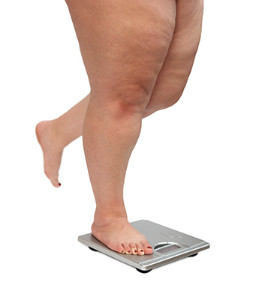 Research has shown there is a connection between increased foot pain and an elevated body weight. The foot condition known as plantar fasciitis may be one of the ailments that may occur as a possible result of additional weight the feet must endure. The pain may ease mildly when gentle exercise is performed, however many patients may be unable to take advantage of this because the weight may prevent them from exercising correctly. There have been studies that have been performed that may suggest a link between obesity and additional foot conditions including bunions, flat feet, or tendonitis. Many people may develop these and other foot conditions despite the fact that a conclusion was not able to be reached. If you would like additional information about how obesity can affect your feet, it’s suggested to consult with a podiatrist.
Research has shown there is a connection between increased foot pain and an elevated body weight. The foot condition known as plantar fasciitis may be one of the ailments that may occur as a possible result of additional weight the feet must endure. The pain may ease mildly when gentle exercise is performed, however many patients may be unable to take advantage of this because the weight may prevent them from exercising correctly. There have been studies that have been performed that may suggest a link between obesity and additional foot conditions including bunions, flat feet, or tendonitis. Many people may develop these and other foot conditions despite the fact that a conclusion was not able to be reached. If you would like additional information about how obesity can affect your feet, it’s suggested to consult with a podiatrist.
Obesity has become very problematic at this point in time and can have extremely negative effects on the feet. If you’re an obese individual and are concerned about your feet, contact Dr. Joshua David Scoll from Pennsylvania. Our doctor can provide the care you need to keep you pain-free and on your feet.
Obesity and Your Feet
Since your feet are what support your entire weight when standing, any additional weight can result in pain and swelling. Being overweight is one of the main contributors to foot complications.
Problems & Complications
Extra Weight – Even putting on just a few extra pounds could create serious complications for your feet. As your weight increases, your balance and body will shift, creating new stresses on your feet. This uneven weight distribution can cause pain, even while doing the simplest tasks, such as walking.
Diabetes – People who are overweight are at serious risk of developing type-2 diabetes, which has a drastic impact on the health of your feet. As you get older, your diabetes might worsen, which could lead to loss of feeling in your feet, sores, and bruises. You could also become more prone to various infections.
Plantar fasciitis – Pressure and stress that is placed on muscles, joints, and tendons can trigger plantar fasciitis, which is an inflammation of tissue that forms along the bottom of the foot.
If you have any questions please feel free to contact one of our offices located in Philadelphia, Bensalem, and Fairless Hills, PA . We offer the newest diagnostic and treatment technologies for all your foot and ankle needs.
Possible Causes of Ingrown Toenails
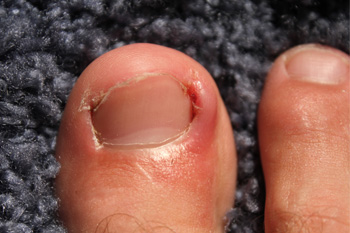 Many children may experience the pain of an ingrown toenail and be unaware of what the condition is. Some of the symptoms may be a liquid oozing from the nail, redness, or severe tenderness. It is typically the result of the toenail being trimmed too short or incorrectly, and may develop quickly. If this condition is not treated promptly, a painful and serious infection may develop. Other people may experience this ailment occurring from wearing shoes that are too tight, an object falling on the toe, which may cause a severe injury, or an activity that is repeated such as kicking a soccer ball. For severe ingrown toenails, surgery may be necessary to remove a portion of the nail. If you have an ingrown toenail, please speak with a podiatrist who can implement the proper treatment methods.
Many children may experience the pain of an ingrown toenail and be unaware of what the condition is. Some of the symptoms may be a liquid oozing from the nail, redness, or severe tenderness. It is typically the result of the toenail being trimmed too short or incorrectly, and may develop quickly. If this condition is not treated promptly, a painful and serious infection may develop. Other people may experience this ailment occurring from wearing shoes that are too tight, an object falling on the toe, which may cause a severe injury, or an activity that is repeated such as kicking a soccer ball. For severe ingrown toenails, surgery may be necessary to remove a portion of the nail. If you have an ingrown toenail, please speak with a podiatrist who can implement the proper treatment methods.
Ingrown toenails can become painful if they are not treated properly. For more information about ingrown toenails, contact Dr. Joshua David Scoll of Pennsylvania. Our doctor can provide the care you need to keep you pain-free and on your feet.
Ingrown Toenails
Ingrown toenails occur when a toenail grows sideways into the bed of the nail, causing pain, swelling, and possibly infection.
Causes
- Bacterial infections
- Improper nail cutting such as cutting it too short or not straight across
- Trauma to the toe, such as stubbing, which causes the nail to grow back irregularly
- Ill-fitting shoes that bunch the toes too close together
- Genetic predisposition
Prevention
Because ingrown toenails are not something found outside of shoe-wearing cultures, going barefoot as often as possible will decrease the likeliness of developing ingrown toenails. Wearing proper fitting shoes and using proper cutting techniques will also help decrease your risk of developing ingrown toenails.
Treatment
Ingrown toenails are a very treatable foot condition. In minor cases, soaking the affected area in salt or antibacterial soaps will not only help with the ingrown nail itself, but also help prevent any infections from occurring. In more severe cases, surgery is an option. In either case, speaking to your podiatrist about this condition will help you get a better understanding of specific treatment options that are right for you.
If you have any questions please feel free to contact one of our offices located in Philadelphia, Bensalem, and Fairless Hills, PA . We offer the newest diagnostic and treatment technologies for all your foot and ankle needs.
The Causes of Gout
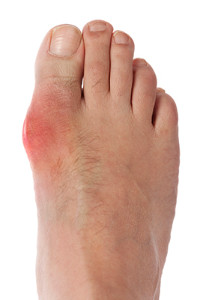 Some of the symptoms that accompany the type of arthritis referred to as gout may be pain and stiffness in the joints of the big toe and surrounding areas. The main cause of this condition originates from excess uric acid that accumulates in the blood stream. Research has shown that many gout attacks occur without warning and often while sleeping, and typically affects the bottom of the big toe. There are several types of food that may cause this ailment, including red meat, certain kinds of seafood, in addition to ingesting an overabundance of alcohol, which may play a significant role in developing gout. Some people may be more susceptible to developing gout, and these may include having a genetic disposition, specific medications, and being overweight. Preventative remedies may include drinking plenty of fresh water daily in addition to adapting healthy lifestyle changes. If you are affected with gout, it’s suggested to consult with a podiatrist to learn about proper treatment options.
Some of the symptoms that accompany the type of arthritis referred to as gout may be pain and stiffness in the joints of the big toe and surrounding areas. The main cause of this condition originates from excess uric acid that accumulates in the blood stream. Research has shown that many gout attacks occur without warning and often while sleeping, and typically affects the bottom of the big toe. There are several types of food that may cause this ailment, including red meat, certain kinds of seafood, in addition to ingesting an overabundance of alcohol, which may play a significant role in developing gout. Some people may be more susceptible to developing gout, and these may include having a genetic disposition, specific medications, and being overweight. Preventative remedies may include drinking plenty of fresh water daily in addition to adapting healthy lifestyle changes. If you are affected with gout, it’s suggested to consult with a podiatrist to learn about proper treatment options.
Gout is a painful condition that can be treated. If you are seeking treatment, contact Dr. Joshua David Scoll from Pennsylvania. Our doctor will treat your foot and ankle needs.
What Is Gout?
Gout is a form of arthritis that is characterized by sudden, severe attacks of pain, redness, and tenderness in the joints. The condition usually affects the joint at the base of the big toe. A gout attack can occur at any random time, such as the middle of the night while you are asleep.
Symptoms
- Intense Joint Pain - Usually around the large joint of your big toe, and it most severe within the first four to twelve hours
- Lingering Discomfort - Joint discomfort may last from a few days to a few weeks
- Inflammation and Redness -Affected joints may become swollen, tender, warm and red
- Limited Range of Motion - May experience a decrease in joint mobility
Risk Factors
- Genetics - If family members have gout, you’re more likely to have it
- Medications - Diuretic medications can raise uric acid levels
- Gender/Age - Gout is more common in men until the age of 60. It is believed that estrogen protects women until that point
- Diet - Eating red meat and shellfish increases your risk
- Alcohol - Having more than two alcoholic drinks per day increases your risk
- Obesity - Obese people are at a higher risk for gout
Prior to visiting your podiatrist to receive treatment for gout, there are a few things you should do beforehand. If you have gout you should write down your symptoms--including when they started and how often you experience them, important medical information you may have, and any questions you may have. Writing down these three things will help your podiatrist in assessing your specific situation so that he or she may provide the best route of treatment for you.
If you have any questions, please feel free to contact one of our offices located in Philadelphia, Bensalem, and Fairless Hills, PA . We offer the newest diagnostic and treatment technologies for all your foot care needs.
Possible Causes of Poor Circulation in the Feet
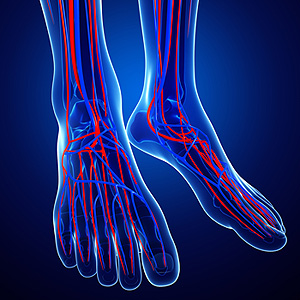 If you have poor circulation in your feet, it may be indicative of unnoticed health issues. The circulatory system may be negatively affected if you sit for extended periods of time, are obese, or if moderate exercise and stretching is not part of your daily routine. Recent research has shown that a condition, which is referred to as atherosclerosis, may be a common cause of poor circulation in the feet. This may be a result of the arteries becoming narrow, which may lead to blockages in the legs. A common symptom of this ailment may be a loss of feeling in the toes or some patients may experience a tingling sensation. Some preventative measures may include a healthy dietary change added to a routine exercise regime. If you have symptoms of poor circulation in the feet, please consult with a podiatrist for additional information.
If you have poor circulation in your feet, it may be indicative of unnoticed health issues. The circulatory system may be negatively affected if you sit for extended periods of time, are obese, or if moderate exercise and stretching is not part of your daily routine. Recent research has shown that a condition, which is referred to as atherosclerosis, may be a common cause of poor circulation in the feet. This may be a result of the arteries becoming narrow, which may lead to blockages in the legs. A common symptom of this ailment may be a loss of feeling in the toes or some patients may experience a tingling sensation. Some preventative measures may include a healthy dietary change added to a routine exercise regime. If you have symptoms of poor circulation in the feet, please consult with a podiatrist for additional information.
While poor circulation itself isn’t a condition; it is a symptom of another underlying health condition you may have. If you have any concerns with poor circulation in your feet contact Dr. Joshua David Scoll of Pennsylvania. Our doctor will treat your foot and ankle needs.
Poor Circulation in the Feet
Peripheral artery disease (PAD) can potentially lead to poor circulation in the lower extremities. PAD is a condition that causes the blood vessels and arteries to narrow. In a linked condition called atherosclerosis, the arteries stiffen up due to a buildup of plaque in the arteries and blood vessels. These two conditions can cause a decrease in the amount of blood that flows to your extremities, therefore resulting in pain.
Symptoms
Some of the most common symptoms of poor circulation are:
- Numbness
- Tingling
- Throbbing or stinging pain in limbs
- Pain
- Muscle Cramps
Treatment for poor circulation often depends on the underlying condition that causes it. Methods for treatment may include insulin for diabetes, special exercise programs, surgery for varicose veins, or compression socks for swollen legs.
As always, see a podiatrist as he or she will assist in finding a regimen that suits you. A podiatrist can also prescribe you any needed medication.
If you have any questions, please feel free to contact one of our offices located in Philadelphia, Bensalem, and Fairless Hills, PA . We offer the newest diagnostic and treatment technologies for all your foot care needs.
How Sesamoiditis Develops
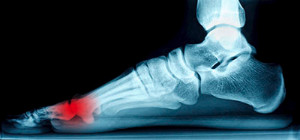 The bones in the body that are connected to the muscles by tendons are referred to as sesamoids. If the tendons in the feet become inflamed, a condition called sesamoiditis may develop. The symptoms that typically accompany this ailment may be swelling as a result of painful inflammation, which commonly occurs on the sole of the foot. The big toe is generally affected, and there may be difficulty in moving it. Women who frequently wear high heels may be at greater risk to develop sesamoiditis, in addition to athletes who participate in running sports such as basketball or soccer. A proper diagnosis is typically accomplished by having an X-ray of your foot performed, or in more severe cases, a bone scan, MRI, or ultrasound may be necessary. Research has shown that it’s helpful to cease the activity that may have caused this condition to develop, and this may alleviate painful symptoms. It’s advised to consult with a podiatrist for additional information on how to treat sesamoiditis.
The bones in the body that are connected to the muscles by tendons are referred to as sesamoids. If the tendons in the feet become inflamed, a condition called sesamoiditis may develop. The symptoms that typically accompany this ailment may be swelling as a result of painful inflammation, which commonly occurs on the sole of the foot. The big toe is generally affected, and there may be difficulty in moving it. Women who frequently wear high heels may be at greater risk to develop sesamoiditis, in addition to athletes who participate in running sports such as basketball or soccer. A proper diagnosis is typically accomplished by having an X-ray of your foot performed, or in more severe cases, a bone scan, MRI, or ultrasound may be necessary. Research has shown that it’s helpful to cease the activity that may have caused this condition to develop, and this may alleviate painful symptoms. It’s advised to consult with a podiatrist for additional information on how to treat sesamoiditis.
Sesamoiditis is an unpleasant foot condition characterized by pain in the balls of the feet. If you think you’re struggling with sesamoiditis, contact Dr. Joshua David Scoll of Pennsylvania. Our doctor will treat your condition thoroughly and effectively.
Sesamoiditis
Sesamoiditis is a condition of the foot that affects the ball of the foot. It is more common in younger people than it is in older people. It can also occur with people who have begun a new exercise program, since their bodies are adjusting to the new physical regimen. Pain may also be caused by the inflammation of tendons surrounding the bones. It is important to seek treatment in its early stages because if you ignore the pain, this condition can lead to more serious problems such as severe irritation and bone fractures.
Causes of Sesamoiditis
- Sudden increase in activity
- Increase in physically strenuous movement without a proper warm up or build up
- Foot structure: those who have smaller, bonier feet or those with a high arch may be more susceptible
Treatment for sesamoiditis is non-invasive and simple. Doctors may recommend a strict rest period where the patient forgoes most physical activity. This will help give the patient time to heal their feet through limited activity. For serious cases, it is best to speak with your doctor to determine a treatment option that will help your specific needs.
If you have any questions please feel free to contact one of our offices located in Philadelphia, Bensalem, and Fairless Hills, PA . We offer the newest diagnostic and treatment technologies for all your foot and ankle needs.
Treating Athlete’s Foot
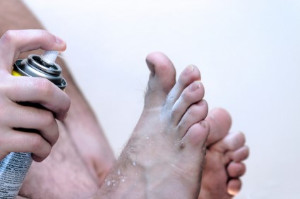 Athlete’s foot, also known as tinea pedis, is a common fungal infection that can affect people who work out at public gyms. You can develop this condition by wearing tight, sweaty shoes for a long period of time or by walking barefoot on damp surfaces around your gym. This fungal infection is typically described as being itchy and scaly, and it can actually spread to other parts of the body. If you are looking for ways to avoid getting athlete’s foot, you should avoid walking barefoot at the gym, and opt to wear flip-flops instead. However, if you do get athlete’s foot, you may be able to treat it with over-the-counter fungal cream. If the cream doesn’t work for you, you may want to see your podiatrist to find a treatment option for your specific case.
Athlete’s foot, also known as tinea pedis, is a common fungal infection that can affect people who work out at public gyms. You can develop this condition by wearing tight, sweaty shoes for a long period of time or by walking barefoot on damp surfaces around your gym. This fungal infection is typically described as being itchy and scaly, and it can actually spread to other parts of the body. If you are looking for ways to avoid getting athlete’s foot, you should avoid walking barefoot at the gym, and opt to wear flip-flops instead. However, if you do get athlete’s foot, you may be able to treat it with over-the-counter fungal cream. If the cream doesn’t work for you, you may want to see your podiatrist to find a treatment option for your specific case.
Athlete’s Foot
Athlete’s foot is often an uncomfortable condition to experience. Thankfully, podiatrists specialize in treating athlete’s foot and offer the best treatment options. If you have any questions about athlete’s foot, consult with Dr. Joshua David Scoll from Pennsylvania. Our doctor will assess your condition and provide you with quality treatment.
What Is Athlete’s Foot?
Tinea pedis, more commonly known as athlete’s foot, is a non-serious and common fungal infection of the foot. Athlete’s foot is contagious and can be contracted by touching someone who has it or infected surfaces. The most common places contaminated by it are public showers, locker rooms, and swimming pools. Once contracted, it grows on feet that are left inside moist, dark, and warm shoes and socks.
Prevention
The most effective ways to prevent athlete’s foot include:
- Thoroughly washing and drying feet
- Avoid going barefoot in locker rooms and public showers
- Using shower shoes in public showers
- Wearing socks that allow the feet to breathe
- Changing socks and shoes frequently if you sweat a lot
Symptoms
Athlete’s foot initially occurs as a rash between the toes. However, if left undiagnosed, it can spread to the sides and bottom of the feet, toenails, and if touched by hand, the hands themselves. Symptoms include:
- Redness
- Burning
- Itching
- Scaly and peeling skin
Diagnosis and Treatment
Diagnosis is quick and easy. Skin samples will be taken and either viewed under a microscope or sent to a lab for testing. Sometimes, a podiatrist can diagnose it based on simply looking at it. Once confirmed, treatment options include oral and topical antifungal medications.
If you have any questions, please feel free to contact one of our offices located in Philadelphia, Bensalem, and Fairless Hills, PA . We offer the newest diagnostic and treatment technologies for all your foot care needs.
Bunions May Lead to Additional Foot Conditions
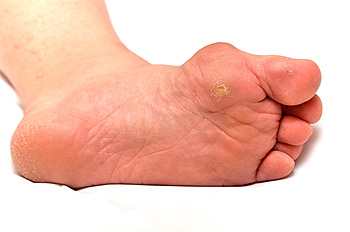 If you see a small bony area at the base and side of the big toe, you may have what is known as a bunion. This is typically a result of a deformed bone structure, and it appears as if the feet are not aligned correctly. There may be several causes for bunions to form, including having low arches, which may lead to instability as walking occurs, medical conditions such as rheumatoid arthritis, or injuries that the foot may have incurred. Recent research has shown that women who frequently wear high heels could cause a pre-existing case of bunions to become worse, and may notice that the toes do not have enough room to move about. The area may feel tender and appear red, possibly accompanied by swelling and a burning sensation. Complications may develop as a result of not seeking medical treatment. Many patients may experience calluses and difficulty in walking when bunions have developed, and it’s suggested to seek the counsel of a podiatrist, who may provide information about the correct treatment options.
If you see a small bony area at the base and side of the big toe, you may have what is known as a bunion. This is typically a result of a deformed bone structure, and it appears as if the feet are not aligned correctly. There may be several causes for bunions to form, including having low arches, which may lead to instability as walking occurs, medical conditions such as rheumatoid arthritis, or injuries that the foot may have incurred. Recent research has shown that women who frequently wear high heels could cause a pre-existing case of bunions to become worse, and may notice that the toes do not have enough room to move about. The area may feel tender and appear red, possibly accompanied by swelling and a burning sensation. Complications may develop as a result of not seeking medical treatment. Many patients may experience calluses and difficulty in walking when bunions have developed, and it’s suggested to seek the counsel of a podiatrist, who may provide information about the correct treatment options.
If you are suffering from bunions, contact Dr. Joshua David Scoll of Pennsylvania. Our doctor can provide the care you need to keep you pain-free and on your feet.
What Is a Bunion?
A bunion is formed of swollen tissue or an enlargement of boney growth, usually located at the base joint of the toe that connects to the foot. The swelling occurs due to the bones in the big toe shifting inward, which impacts the other toes of the foot. This causes the area around the base of the big toe to become inflamed and painful.
Why Do Bunions Form?
Genetics – Susceptibility to bunions are often hereditary
Stress on the feet – Poorly fitted and uncomfortable footwear that places stress on feet, such as heels, can worsen existing bunions
How Are Bunions Diagnosed?
Doctors often perform two tests – blood tests and x-rays – when trying to diagnose bunions, especially in the early stages of development. Blood tests help determine if the foot pain is being caused by something else, such as arthritis, while x-rays provide a clear picture of your bone structure to your doctor.
How Are Bunions Treated?
- Refrain from wearing heels or similar shoes that cause discomfort
- Select wider shoes that can provide more comfort and reduce pain
- Anti-inflammatory and pain management drugs
- Orthotics or foot inserts
- Surgery
If you have any questions, please feel free to contact one of our offices located in Philadelphia, Bensalem, and Fairless Hills, PA . We offer the newest diagnostic and treatment technologies for all your foot care needs.
What Causes Athlete’s Foot?
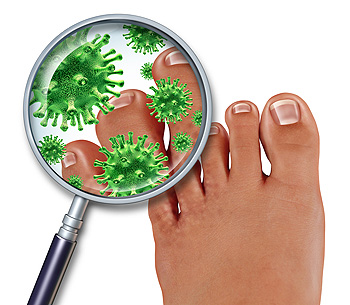 There are several obvious symptoms that are associated with athlete’s foot, including itching, blisters, and cracked skin between the toes. Fortunately, moderate relief can be found with proper treatment. This condition is caused by a fungus, and it often thrives in warm and moist areas such as public pools, showers, and surrounding areas. It is known to be contagious, and it can be prevented by wearing appropriate shoes when visiting these areas. It may be beneficial to wear shoes that allow the feet to breathe in addition to wearing cotton socks that will aid in absorbing sweat. There are several treatment options available and it’s advised to consult with a podiatrist to determine which treatment is best for you.
There are several obvious symptoms that are associated with athlete’s foot, including itching, blisters, and cracked skin between the toes. Fortunately, moderate relief can be found with proper treatment. This condition is caused by a fungus, and it often thrives in warm and moist areas such as public pools, showers, and surrounding areas. It is known to be contagious, and it can be prevented by wearing appropriate shoes when visiting these areas. It may be beneficial to wear shoes that allow the feet to breathe in addition to wearing cotton socks that will aid in absorbing sweat. There are several treatment options available and it’s advised to consult with a podiatrist to determine which treatment is best for you.
Athlete’s foot is an inconvenient condition that can be easily reduced with the proper treatment. If you have any concerns about your feet and ankles, contact Dr. Joshua David Scoll from Pennsylvania. Our doctor will treat your foot and ankle needs.
Athlete’s Foot: The Sole Story
Athlete's foot, also known as tinea pedis, can be an extremely contagious foot infection. It is commonly contracted in public changing areas and bathrooms, dormitory style living quarters, around locker rooms and public swimming pools, or anywhere your feet often come into contact with other people.
Solutions to Combat Athlete’s Foot
- Hydrate your feet by using lotion
- Exfoliate
- Buff off nails
- Use of anti-fungal products
- Examine your feet and visit your doctor if any suspicious blisters or cuts develop
Athlete’s foot can cause many irritating symptoms such as dry and flaking skin, itching, and redness. Some more severe symptoms can include bleeding and cracked skin, intense itching and burning, and even pain when walking. In the worst cases, Athlete’s foot can cause blistering as well. Speak to your podiatrist for a better understanding of the different causes of Athlete’s foot, as well as help in determining which treatment options are best for you.
If you have any questions please feel free to contact one of our offices located in Philadelphia, Bensalem, and Fairless Hills, PA . We offer the newest diagnostic and treatment technologies for all your foot and ankle needs.
Actor Mario Lopez Injures Achilles Tendon
 TV host Mario Lopez suffered a serious injury on the fourth of July. His snapchat update revealed that the actor ruptured his Achilles tendon. Along with the photo, Lopez wrote a caption that read, “Celebrating the 4th in the E.R...Tore my achilles sparring. Ugh.. So frustrated.” Three days later, he posted a picture of himself giving a thumbs-up after the success of his surgery. The recovery period for Lopez’s injury is expected to be approximately four to six months. Achilles tendon injuries affect the back of the lower leg. An overstretch of this tendon can either tear partially or completely. Many people who tear their Achilles tendons hear a popping sound after suffering the injury. If you are experiencing pain in your Achilles tendon, you should seek treatment from your podiatrist.
TV host Mario Lopez suffered a serious injury on the fourth of July. His snapchat update revealed that the actor ruptured his Achilles tendon. Along with the photo, Lopez wrote a caption that read, “Celebrating the 4th in the E.R...Tore my achilles sparring. Ugh.. So frustrated.” Three days later, he posted a picture of himself giving a thumbs-up after the success of his surgery. The recovery period for Lopez’s injury is expected to be approximately four to six months. Achilles tendon injuries affect the back of the lower leg. An overstretch of this tendon can either tear partially or completely. Many people who tear their Achilles tendons hear a popping sound after suffering the injury. If you are experiencing pain in your Achilles tendon, you should seek treatment from your podiatrist.
Achilles tendon injuries need immediate attention to avoid future complications. If you have any concerns, contact Dr. Joshua David Scoll of Pennsylvania. Our doctor can provide the care you need to keep you pain-free and on your feet.
What Is the Achilles Tendon?
The Achilles tendon is a tendon that connects the lower leg muscles and calf to the heel of the foot. It is the strongest tendon in the human body and is essential for making movement possible. Because this tendon is such an integral part of the body, any injuries to it can create immense difficulties and should immediately be presented to a doctor.
What Are the Symptoms of an Achilles Tendon Injury?
There are various types of injuries that can affect the Achilles tendon. The two most common injuries are Achilles tendinitis and ruptures of the tendon.
Achilles Tendinitis Symptoms
- Inflammation
- Dull to severe pain
- Increased blood flow to the tendon
- Thickening of the tendon
Rupture Symptoms
- Extreme pain and swelling in the foot
- Total immobility
Treatment and Prevention
Achilles tendon injuries are diagnosed by a thorough physical evaluation, which can include an MRI. Treatment involves rest, physical therapy, and in some cases, surgery. However, various preventative measures can be taken to avoid these injuries, such as:
- Thorough stretching of the tendon before and after exercise
- Strengthening exercises like calf raises, squats, leg curls, leg extensions, leg raises, lunges, and leg presses
If you have any questions please feel free to contact one of our offices located in Philadelphia, Bensalem, and Fairless Hills, PA . We offer the newest diagnostic tools and technology to treat your foot and ankle needs.
Why Do I Have Poor Circulation?
 If you experience numbness or a tingling sensation in the feet, you may have poor circulation. Additionally, some patients may feel a cramping or coldness in their toes and this may often be the result of the inability of the circulatory system to transport blood to the cells of the body. A condition known as peripheral vascular disease, which is also referred to as PVD, may often occur when the veins or arteries become blocked. This may cause wounds on the feet to heal slower than average, and may often be accompanied by a decrease in body temperature, which may cause the feet to feel cold. Research has shown that heart disease may be a leading cause of poor circulation, and this may include a specific condition known as arrhythmias, or an irregular heartbeat. If you are experiencing symptoms that are indicative of poor circulation in the feet, it’s advised to schedule a consultation with a podiatrist for additional information, including treatment options.
If you experience numbness or a tingling sensation in the feet, you may have poor circulation. Additionally, some patients may feel a cramping or coldness in their toes and this may often be the result of the inability of the circulatory system to transport blood to the cells of the body. A condition known as peripheral vascular disease, which is also referred to as PVD, may often occur when the veins or arteries become blocked. This may cause wounds on the feet to heal slower than average, and may often be accompanied by a decrease in body temperature, which may cause the feet to feel cold. Research has shown that heart disease may be a leading cause of poor circulation, and this may include a specific condition known as arrhythmias, or an irregular heartbeat. If you are experiencing symptoms that are indicative of poor circulation in the feet, it’s advised to schedule a consultation with a podiatrist for additional information, including treatment options.
Poor circulation is a serious condition and needs immediate medical attention. If you have any concerns with poor circulation in your feet contact Dr. Joshua David Scoll of Pennsylvania. Our doctor will treat your foot and ankle needs.
Poor Circulation in the Feet
Poor blood circulation in the feet and legs is can be caused by peripheral artery disease (PAD), which is the result of a buildup of plaque in the arteries.
Plaque buildup or atherosclerosis results from excess calcium and cholesterol in the bloodstream. This can restrict the amount of blood which can flow through the arteries. Poor blood circulation in the feet and legs are sometimes caused by inflammation in the blood vessels, known as vasculitis.
Causes
Lack of oxygen and oxygen from poor blood circulation restricts muscle growth and development. It can also cause:
- Muscle pain, stiffness, or weakness
- Numbness or cramping in the legs
- Skin discoloration
- Slower nail & hair growth
- Erectile dysfunction
Those who have diabetes or smoke are at greatest risk for poor circulation, as are those who are over 50. If you have poor circulation in the feet and legs it may be caused by PAD and is important to make changes to your lifestyle in order to reduce risk of getting a heart attack or stroke. Exercise and maintaining a healthy lifestyle will dramatically improve conditions.
As always, see a podiatrist as he or she will assist in finding a regimen that suits you. A podiatrist can also prescribe you any needed medication.
If you have any questions please feel free to contact one of our offices located in Philadelphia, Bensalem, and Fairless Hills, PA . We offer the newest diagnostic and treatment technologies for all your foot and ankle needs.
Orioles Pitcher Sprains Ankle
 Right hander Dylan Bundy of the Baltimore Orioles suffered an ankle sprain in a game versus the Atlanta Braves. This injury has placed Bundy on the 10-day disabled list and it has forced the team to look to the minor leagues to find his replacement. When asked about the injury, Orioles’ manager Buck Showalter said, “It's the landing foot. He rolled it coming around third base in Atlanta in this stuff called interleague games.” Much of Showalter’s decision making process in placing Bundy on the disabled list was related to the fact that the team was expected to play another interleague game against the Phillies. The manager wanted to give Bundy extra rest so that his injury will not be aggravated during interleague play. If you are suffering from an ankle sprain, you should speak with your podiatrist to see which treatment option is best for you. It is very likely that he or she will recommend you take time away from any strenuous activity to nurse your ankle back to health.
Right hander Dylan Bundy of the Baltimore Orioles suffered an ankle sprain in a game versus the Atlanta Braves. This injury has placed Bundy on the 10-day disabled list and it has forced the team to look to the minor leagues to find his replacement. When asked about the injury, Orioles’ manager Buck Showalter said, “It's the landing foot. He rolled it coming around third base in Atlanta in this stuff called interleague games.” Much of Showalter’s decision making process in placing Bundy on the disabled list was related to the fact that the team was expected to play another interleague game against the Phillies. The manager wanted to give Bundy extra rest so that his injury will not be aggravated during interleague play. If you are suffering from an ankle sprain, you should speak with your podiatrist to see which treatment option is best for you. It is very likely that he or she will recommend you take time away from any strenuous activity to nurse your ankle back to health.
Ankle sprains are common but need immediate attention. If you need your feet checked, contact Dr. Joshua David Scoll from Pennsylvania. Our doctor can provide the care you need to keep you pain-free and on your feet.
How Does an Ankle Sprain Occur?
Ankle sprains take place when the ligaments in your ankle are torn or stretched beyond their limits. There are multiple ways that the ankle can become injured, including twisting or rolling over onto your ankle, putting undue stress on it, or causing trauma to the ankle itself.
What Are the Symptoms?
- Mild to moderate bruising
- Limited mobility
- Swelling
- Discoloration of the skin (depending on severity)
Preventing a Sprain
- Wearing appropriate shoes for the occasion
- Stretching before exercises and sports
- Knowing your limits
Treatment of a Sprain
Treatment of a sprain depends on the severity. Many times, people are told to rest and remain off their feet completely, while others are given an air cast. If the sprain is very severe, surgery may be required.
If you have suffered an ankle sprain previously, you may want to consider additional support such as a brace and regular exercises to strengthen the ankle.
If you have any questions please feel free to contact one of our offices located in Philadelphia, Bensalem, and Fairless Hills, PA . We offer the newest diagnostic and treatment technologies for all your foot and ankle needs.
Is Laser Treatment an Effective Way to Treat Toenail Fungus?
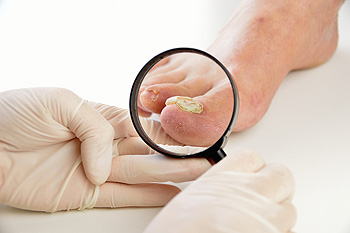 Another name for a common condition referred to as toenail fungus, is onychomycosis. General treatment options typically include using topical creams or liquids, despite being relatively ineffective. Recent research has shown the onset of using laser therapies, which may be an effective option for the treatment of toenail fungus. The concept may be an advanced approach, which may diminish the severity of this condition by injecting a specific amount of light into the affected toenail. There is insufficient information available than can justify the effectiveness of laser treatment and it has been suggested to consider this type of treatment when other remedies have failed. Please consult with a podiatrist for additional information about laser treatments.
Another name for a common condition referred to as toenail fungus, is onychomycosis. General treatment options typically include using topical creams or liquids, despite being relatively ineffective. Recent research has shown the onset of using laser therapies, which may be an effective option for the treatment of toenail fungus. The concept may be an advanced approach, which may diminish the severity of this condition by injecting a specific amount of light into the affected toenail. There is insufficient information available than can justify the effectiveness of laser treatment and it has been suggested to consider this type of treatment when other remedies have failed. Please consult with a podiatrist for additional information about laser treatments.
Laser treatment can be an effective way to get rid of toenail fungus. If you have any questions about laser treatment, consult with Dr. Joshua David Scoll from Pennsylvania. Our doctor will assess your condition and provide you with quality treatment for fungal nails.
What Are Toenail Fungal Infections?
Onychomycosis, or fungal infection of the nail, is a relatively common and non-serious condition. Around 10 percent of U.S. citizens are afflicted with fungal nails. Common forms of fungus that infect the nail include dermatophytes, yeasts, and molds.
Symptoms of Toenail Fungal Infections Include:
- Nail thickening
- Brittleness of the nail
- Discoloration of the nail
Diagnosis for Fungal Nails
Fungal infections are diagnosed by fungal culture and microscopy. This will rule out any other conditions such as nail trauma, psoriasis, lichen planus, and onychogryphosis.
What Is Laser Treatment?
Laser treatment is a non-invasive, safe, quick, and painless procedure that uses the heat from a laser to kill fungus in the nail. Each infected nail is targeted with a laser for several minutes. The treatment is usually utilized several different times over a select period. During this time, a podiatrist will keep an eye on the infection.
If you have any questions, please feel free to contact one of our offices located in Philadelphia, Bensalem, and Fairless Hills, PA . We offer the newest diagnostic and treatment technologies for all your foot care needs.
Tips on Avoiding Blisters this Summer
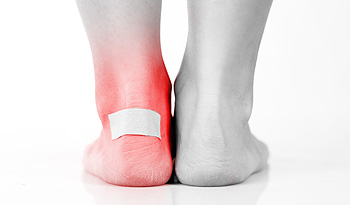 Blisters are defined as small pockets of fluid that form as a result of friction. They can be painful and they may ruin the appearance of your feet. One of the most common reasons why blisters develop is a result of wearing poorly-fitting shoes. Shoes that are either too tight or too loose may cause the foot to rub against the shoe excessively. As a result, friction occurs, which may lead to a blister forming. This same occurrence also happens when people choose to not wear socks. A great way to avoid blisters in the summertime is to put talcum powder on your feet after cleaning them, because damp and sweaty skin is more vulnerable to blisters. If you experience any blisters that have difficulty healing or change colors, a consultation with a podiatrist is advised.
Blisters are defined as small pockets of fluid that form as a result of friction. They can be painful and they may ruin the appearance of your feet. One of the most common reasons why blisters develop is a result of wearing poorly-fitting shoes. Shoes that are either too tight or too loose may cause the foot to rub against the shoe excessively. As a result, friction occurs, which may lead to a blister forming. This same occurrence also happens when people choose to not wear socks. A great way to avoid blisters in the summertime is to put talcum powder on your feet after cleaning them, because damp and sweaty skin is more vulnerable to blisters. If you experience any blisters that have difficulty healing or change colors, a consultation with a podiatrist is advised.
Blisters may appear as a single bubble or in a cluster. They can cause a lot of pain and may be filled with pus, blood, or watery serum. If your feet are hurting, contact Dr. Joshua David Scoll of Pennsylvania. Our doctor can provide the care you need to keep you pain-free and on your feet.
Foot Blisters
Foot blisters are often the result of friction. This happens due to the constant rubbing from shoes, which can lead to pain.
What Are Foot Blisters?
A foot blister is a small fluid-filled pocket that forms on the upper-most layer of the skin. Blisters are filled with clear fluid and can lead to blood drainage or pus if the area becomes infected.
Symptoms
(Blister symptoms may vary depending on what is causing them)
- Bubble of skin filled with fluid
- Redness
- Moderate to severe pain
- Itching
Prevention & Treatment
In order to prevent blisters, you should be sure to wear comfortable shoes with socks that cushion your feet and absorb sweat. Breaking a blister open may increase your chances of developing an infection. However, if your blister breaks, you should wash the area with soap and water immediately and then apply a bandage to the affected area. If your blisters cause severe pain it is important that you call your podiatrist right away.
If you have any questions, please feel free to contact one of our offices located in Philadelphia, Bensalem, and Fairless Hills, PA . We offer the newest diagnostic and treatment technologies for all your foot care needs.
What is the Most Common Place for Falls to Occur?
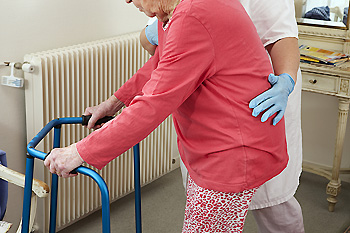 If you should experience a fall, it may not only produce physical distress, but can also incur extreme financial costs. Severe injuries may be the result of a fall, and this may aid in the rise of unwanted medical expenses. Unnatural feelings can be produced by falling, and research has shown there are several ways to prevent this from occurring. It’s important to wear shoes that fit correctly, and having slip-resistance soles may aid in the prevention of falls. Unsurprisingly, the environment in the home may account for the majority of falls occurring. This generally results from carpets that may have loosened from the floor or liquids that may have spill, causing the floor to become slippery. It’s important to use a railing while walking up or down the stairs, and utilizing a handrail in the shower may be beneficial in keeping your balance. Incorporating exercise into your daily routine will strengthen the body and may possibly help avoid falling.
If you should experience a fall, it may not only produce physical distress, but can also incur extreme financial costs. Severe injuries may be the result of a fall, and this may aid in the rise of unwanted medical expenses. Unnatural feelings can be produced by falling, and research has shown there are several ways to prevent this from occurring. It’s important to wear shoes that fit correctly, and having slip-resistance soles may aid in the prevention of falls. Unsurprisingly, the environment in the home may account for the majority of falls occurring. This generally results from carpets that may have loosened from the floor or liquids that may have spill, causing the floor to become slippery. It’s important to use a railing while walking up or down the stairs, and utilizing a handrail in the shower may be beneficial in keeping your balance. Incorporating exercise into your daily routine will strengthen the body and may possibly help avoid falling.
Preventing falls among the elderly is very important. If you are older and have fallen or fear that you are prone to falling, consult with Dr. Joshua David Scoll from Pennsylvania. Our doctor will assess your condition and provide you with quality advice and care.
Every 11 seconds, an elderly American is being treated in an emergency room for a fall related injury. Falls are the leading cause of head and hip injuries for those 65 and older. Due to decreases in strength, balance, senses, and lack of awareness, elderly persons are very susceptible to falling. Thankfully, there are a number of things older persons can do to prevent falls.
How to Prevent Falls
Some effective methods that older persons can do to prevent falls include:
- Enrolling in strength and balance exercise program to increase balance and strength
- Periodically having your sight and hearing checked
- Discuss any medications you have with a doctor to see if it increases the risk of falling
- Clearing the house of falling hazards and installing devices like grab bars and railings
- Utilizing a walker or cane
- Wearing shoes that provide good support and cushioning
- Talking to family members about falling and increasing awareness
Falling can be a traumatic and embarrassing experience for elderly persons; this can make them less willing to leave the house, and less willing to talk to someone about their fears of falling. Doing such things, however, will increase the likelihood of tripping or losing one’s balance. Knowing the causes of falling and how to prevent them is the best way to mitigate the risk of serious injury.
If you have any questions, please feel free to contact one of our offices located in Philadelphia, Bensalem, and Fairless Hills, PA . We offer the newest diagnostic and treatment technologies for all your foot care needs.
Surgery for Bunions
 If you experience a bony growth on the side of the big toe, you may have what is referred to as a bunion. This condition may require surgery to be performed, which will generally provide permanent relief. This surgical procedure typically involves removal of the bony protrusion or possibly a restructuring of the toes, which will depend on the severity of the bunion. Surgery will involve undergoing general or local anesthesia, which is determined based on each individual. There may be several ways to perform this type of operation, and it can typically depend on other factors involving the foot, such as any arthritis that may be present. Recovery includes utilizing a bandage or splint so the foot is protected and can rest comfortably. Crutches may be beneficial to use, which can aid in keeping weight off the toe. If you have a bunion and would like additional information about how surgery can be effective for you, please schedule a consultation with a podiatrist.
If you experience a bony growth on the side of the big toe, you may have what is referred to as a bunion. This condition may require surgery to be performed, which will generally provide permanent relief. This surgical procedure typically involves removal of the bony protrusion or possibly a restructuring of the toes, which will depend on the severity of the bunion. Surgery will involve undergoing general or local anesthesia, which is determined based on each individual. There may be several ways to perform this type of operation, and it can typically depend on other factors involving the foot, such as any arthritis that may be present. Recovery includes utilizing a bandage or splint so the foot is protected and can rest comfortably. Crutches may be beneficial to use, which can aid in keeping weight off the toe. If you have a bunion and would like additional information about how surgery can be effective for you, please schedule a consultation with a podiatrist.
Foot surgery is sometimes necessary to treat a foot ailment. To learn more, contact Dr. Joshua David Scoll of Pennsylvania. Our doctor will assist you with all of your foot and ankle needs.
When Is Surgery Necessary?
Foot and ankle surgery is generally reserved for cases in which less invasive, conservative procedures have failed to alleviate the problem. Some of the cases in which surgery may be necessary include:
- Removing foot deformities like bunions and bone spurs
- Severe arthritis that has caused bone issues
- Cosmetic reconstruction
What Types of Surgery Are There?
The type of surgery you receive will depend on the nature of the problem you have. Some of the possible surgeries include:
- Bunionectomy for painful bunions
- Surgical fusion for realignment of bones
- Neuropathy decompression surgery to treat nerve damage
Benefits of Surgery
Although surgery is usually a last resort, it can provide more complete pain relief compared to non-surgical methods and may allow you to finally resume full activity.
Surgical techniques have also become increasingly sophisticated. Techniques like endoscopic surgery allow for smaller incisions and faster recovery times.
If you have any questions please feel free to contact one of our offices located in Philadelphia, Bensalem, and Fairless Hills, PA . We offer the newest diagnostic and treatment technologies for all your foot and ankle needs.
More...
Where Does Toenail Fungus Come From?
There are several symptoms that are noticeable and will determine if you are afflicted by toenail fungus. The toenail will often appear to be a yellowish color and may be thick and rough in texture. In more severe cases, the toenail may lift from the skin or break off completely. Occasionally, small black dots can be seen on the nail, which is typically considered to be dirt that has collected underneath the toenail. This type of fungus generally thrives in warm and moist surroundings and can typically be found in pool areas and saunas. It will benefit the overall health of the toenail if this condition is treated promptly. This may include undergoing a proper diagnosis, followed by medications that can be applied to the nail for mild cases. Extreme situations may call for oral medications to be ingested, despite certain side effects that may follow. If you are afflicted by this ailment, it’s suggested to consult with a podiatrist for additional information and treatment options relative to toenail fungus.
For more information about treatment, contact Dr. Joshua David Scoll of Pennsylvania. Our doctor can provide the care you need to keep you pain-free and on your feet.
Toenail Fungus Treatment
Toenail fungus is a condition that affects many people and can be especially hard to get rid of. Fortunately, there are several methods to go about treating and avoiding it.
Antifungals & Deterrence
Oral antifungal medicine has been shown to be effective in many cases. It is important to consult with a podiatrist to determine the proper regiment for you, or potentially explore other options.
Applying foot powder on the feet and shoes helps keep the feet free of moisture and sweat.
Sandals or open toed shoes – Wearing these will allow air movement and help keep feet dry. They also expose your feet to light, which fungus cannot tolerate. Socks with moisture wicking material also help as well.
If you have any questions please feel free to contact one of our offices located in Philadelphia, Bensalem, and Fairless Hills, PA . We offer the newest diagnostic tools and technology to treat your foot and ankle needs.
How to Alleviate Swollen Ankles During Pregnancy
 If you have swollen ankles and feet during pregnancy, you are among the majority of the population that experience these uncomfortable side effects. An effective way to alleviate severely swollen ankles is to elevate your feet so they are higher than your heart. This technique makes it easier for additional fluids to drain from your legs that may have accumulated during pregnancy. Additionally, lying on your side while sleeping may result in less pressure the veins typically encounter. There can be physical changes that may occur, including feet that increase in size, or a change in the structure of the foot, which may affect the arch. Research has shown the importance of incorporating walking into your daily routine, periodically stretching your legs and including healthy foods in your daily food intake.
If you have swollen ankles and feet during pregnancy, you are among the majority of the population that experience these uncomfortable side effects. An effective way to alleviate severely swollen ankles is to elevate your feet so they are higher than your heart. This technique makes it easier for additional fluids to drain from your legs that may have accumulated during pregnancy. Additionally, lying on your side while sleeping may result in less pressure the veins typically encounter. There can be physical changes that may occur, including feet that increase in size, or a change in the structure of the foot, which may affect the arch. Research has shown the importance of incorporating walking into your daily routine, periodically stretching your legs and including healthy foods in your daily food intake.
Pregnant women with swollen feet can be treated with a variety of different methods that are readily available. For more information about other cures for swollen feet during pregnancy, consult with Dr. Joshua David Scoll from Pennsylvania. Our doctor will attend to all of your foot and ankle needs.
What Foot Problems Can Arise During Pregnancy?
One problem that can occur is overpronation, which occurs when the arch of the foot flattens and tends to roll inward. This can cause pain and discomfort in your heels while you’re walking or even just standing up, trying to support your baby.
Another problem is edema, or swelling in the extremities. This often affects the feet during pregnancy but tends to occur in the later stages.
How Can I Keep My Feet Healthy During Pregnancy?
- Wearing orthotics can provide extra support for the feet and help distribute weight evenly
- Minimize the amount of time spent walking barefoot
- Wear shoes with good arch support
- Wear shoes that allow for good circulation to the feet
- Elevate feet if you experience swelling
- Massage your feet
- Get regular, light exercise, such as walking, to promote blood circulation to the feet
If you have any questions please feel free to contact one of our offices located in Philadelphia, Bensalem, and Fairless Hills, PA . We offer the newest diagnostic and treatment technologies for all your foot and ankle needs.
Symptoms of Stress Fractures
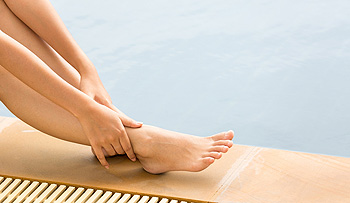 If you are experiencing a dull achy feeling in your feet, you may have what is referred to as a stress fracture. It consists of small cracks in the bones of the feet, and is generally caused by a repetitive stress that’s inflicted on the foot. Causes of this type of fracture may include jogging frequently, adding additional intensity to the duration of the run, or extending the period of time the running activity is pursued. There are several symptoms that may be apparent, including weakness in the foot, and pain that won't cease and eventually worsens, specifically at night. It may be possible to prevent stress fractures from occurring by choosing to wear proper footwear, maintaining a proper nutritional lifestyle, and gradually increasing the intensity of running. After a diagnosis is performed, proper treatment may begin, which may include wearing a cast or undergoing surgery for severe stress fractures. Please consult with a podiatrist to learn more about stress fractures of the foot or ankle.
If you are experiencing a dull achy feeling in your feet, you may have what is referred to as a stress fracture. It consists of small cracks in the bones of the feet, and is generally caused by a repetitive stress that’s inflicted on the foot. Causes of this type of fracture may include jogging frequently, adding additional intensity to the duration of the run, or extending the period of time the running activity is pursued. There are several symptoms that may be apparent, including weakness in the foot, and pain that won't cease and eventually worsens, specifically at night. It may be possible to prevent stress fractures from occurring by choosing to wear proper footwear, maintaining a proper nutritional lifestyle, and gradually increasing the intensity of running. After a diagnosis is performed, proper treatment may begin, which may include wearing a cast or undergoing surgery for severe stress fractures. Please consult with a podiatrist to learn more about stress fractures of the foot or ankle.
Activities where too much pressure is put on the feet can cause stress fractures. To learn more, contact Dr. Joshua David Scoll from Pennsylvania. Our doctor can provide the care you need to keep your pain free and on your feet.
Dealing with Stress Fractures of the Foot and Ankle
Stress fractures occur in the foot and ankle when muscles in these areas weaken from too much or too little use. The feet and ankles then lose support when walking or running from the impact of the ground. Since there is no protection, the bones receive the full impact of each step. Stress on the feet can cause cracks to form in the bones, thus creating stress fractures.
What Are Stress Fractures?
Stress fractures occur frequently in individuals whose daily activities cause great impact on the feet and ankles. Stress factors are most common among:
- Runners
- People affected with Osteoporosis
- Tennis or basketball players
- Gymnasts
- High impact workouts
Symptoms
Pain from the fractures occur in the area of the fractures and can be constant or intermittent. It will often cause sharp or dull pain with swelling and tenderness. Engaging in any kind of activity which involves high impact will aggravate pain.
If you have any questions please feel free to contact one of our offices located in Philadelphia, Bensalem, and Fairless Hills, PA . We offer the newest diagnostic and treatment technologies for all your foot and ankle needs.
How Do I Know if I Have Gout?
 The general cause of a condition referred to as gout is an excess of uric acid that accumulates in the body. The big toe is typically affected, and obvious symptoms may include intense pain, swelling, and redness in the surrounding areas. It will often appear as an inflamed protrusion on the side of the big toe, and may affect the ability to walk. Research has shown that it may be a controllable condition and may occur because of the foods that are ingested. There may be several items that may fall into this category, including the consumption of red meat, an excessive salty foods, and any type of shellfish. Drinking excess alcohol may also lead to the development of gout, in addition to a family history of high blood pressure. Occasionally, there may be specific medical conditions in which the body has difficulty eliminating uric acid, such as kidney or thyroid ailments. The treatment for gout can vary, so it’s advised to consult with a podiatrist for a proper diagnosis.
The general cause of a condition referred to as gout is an excess of uric acid that accumulates in the body. The big toe is typically affected, and obvious symptoms may include intense pain, swelling, and redness in the surrounding areas. It will often appear as an inflamed protrusion on the side of the big toe, and may affect the ability to walk. Research has shown that it may be a controllable condition and may occur because of the foods that are ingested. There may be several items that may fall into this category, including the consumption of red meat, an excessive salty foods, and any type of shellfish. Drinking excess alcohol may also lead to the development of gout, in addition to a family history of high blood pressure. Occasionally, there may be specific medical conditions in which the body has difficulty eliminating uric acid, such as kidney or thyroid ailments. The treatment for gout can vary, so it’s advised to consult with a podiatrist for a proper diagnosis.
Gout is a foot condition that requires certain treatment and care. If you are seeking treatment, contact Dr. Joshua David Scoll from Pennsylvania. Our doctor will treat your foot and ankle needs.
What Is Gout?
Gout is a type of arthritis caused by a buildup of uric acid in the bloodstream. It often develops in the foot, especially the big toe area, although it can manifest in other parts of the body as well. Gout can make walking and standing very painful and is especially common in diabetics and the obese.
People typically get gout because of a poor diet. Genetic predisposition is also a factor. The children of parents who have had gout frequently have a chance of developing it themselves.
Gout can easily be identified by redness and inflammation of the big toe and the surrounding areas of the foot. Other symptoms include extreme fatigue, joint pain, and running high fevers. Sometimes corticosteroid drugs can be prescribed to treat gout, but the best way to combat this disease is to get more exercise and eat a better diet.
If you have any questions please feel free to contact one of our offices located in Philadelphia, Bensalem, and Fairless Hills, PA . We offer the newest diagnostic and treatment technologies for all your foot and ankle needs.
How is Morton’s Neuroma Diagnosed?
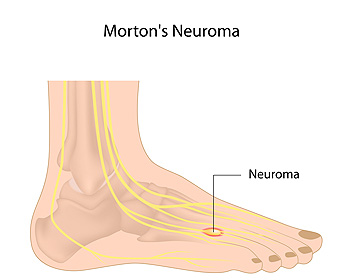 If you have a condition referred to as Morton’s Neuroma, you may be experiencing pain that is felt on the ball of the foot and extends to the bottom of the toes. This condition typically originates from wearing narrow shoes that fit incorrectly and may result in inflammation of surrounding nerves. This generally causes severe pain and discomfort, and relief is found when the offending shoe is removed. This ailment needs to be properly diagnosed, and this often consists of performing an MRI or ultrasound. An additional test may be implemented, which involves pressure that is exerted on the toes and surrounding areas. Once a proper diagnosis has been completed, possible treatment options may consist of wearing efficient arch support or having steroids injected. It’s suggested to consult with a podiatrist if you would like additional information on Morton’s Neuroma.
If you have a condition referred to as Morton’s Neuroma, you may be experiencing pain that is felt on the ball of the foot and extends to the bottom of the toes. This condition typically originates from wearing narrow shoes that fit incorrectly and may result in inflammation of surrounding nerves. This generally causes severe pain and discomfort, and relief is found when the offending shoe is removed. This ailment needs to be properly diagnosed, and this often consists of performing an MRI or ultrasound. An additional test may be implemented, which involves pressure that is exerted on the toes and surrounding areas. Once a proper diagnosis has been completed, possible treatment options may consist of wearing efficient arch support or having steroids injected. It’s suggested to consult with a podiatrist if you would like additional information on Morton’s Neuroma.
Morton’s neuroma is a very uncomfortable condition to live with. If you think you have Morton’s neuroma, contact Dr. Joshua David Scoll of Pennsylvania. Our doctor will attend to all of your foot care needs and answer any of your related questions.
Morton’s Neuroma
Morton's neuroma is a painful foot condition that commonly affects the areas between the second and third or third and fourth toe, although other areas of the foot are also susceptible. Morton’s neuroma is caused by an inflamed nerve in the foot that is being squeezed and aggravated by surrounding bones.
What Increases the Chances of Having Morton’s Neuroma?
- Ill-fitting high heels or shoes that add pressure to the toe or foot
- Jogging, running or any sport that involves constant impact to the foot
- Flat feet, bunions, and any other foot deformities
Morton’s neuroma is a very treatable condition. Orthotics and shoe inserts can often be used to alleviate the pain on the forefront of the feet. In more severe cases, corticosteroids can also be prescribed. In order to figure out the best treatment for your neuroma, it’s recommended to seek the care of a podiatrist who can diagnose your condition and provide different treatment options.
If you have any questions, please feel free to contact one of our offices located in Philadelphia, Bensalem, and Fairless Hills, PA . We offer the newest diagnostic and treatment technologies for all your foot care needs.
